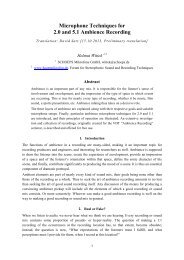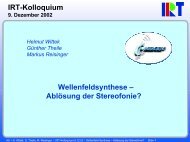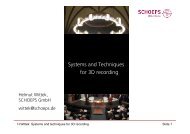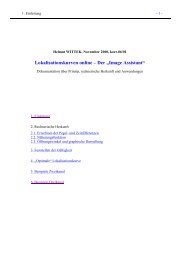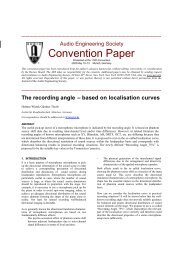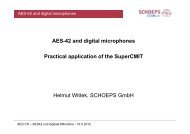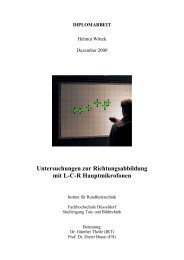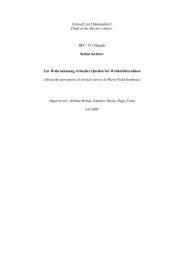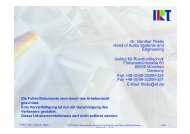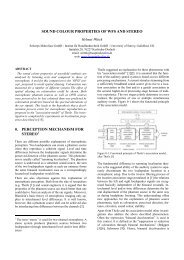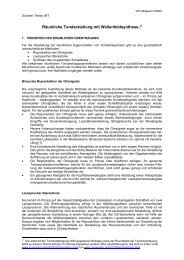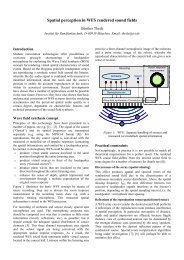on the localisation in the superimposed soundfield - Hauptmikrofon ...
on the localisation in the superimposed soundfield - Hauptmikrofon ...
on the localisation in the superimposed soundfield - Hauptmikrofon ...
You also want an ePaper? Increase the reach of your titles
YUMPU automatically turns print PDFs into web optimized ePapers that Google loves.
28<br />
It is assumed that <strong>the</strong> relati<strong>on</strong>ship between <strong>the</strong> <strong>in</strong>- and output signal can describe <strong>the</strong><br />
behaviour of this hypo<strong>the</strong>tical process<strong>in</strong>g stage. This functi<strong>on</strong>al pr<strong>in</strong>ciple is not meant<br />
to replicate <strong>the</strong> <strong>in</strong>ner structure of <strong>the</strong> sensory process<strong>in</strong>g. Its functi<strong>on</strong><strong>in</strong>g requires <strong>the</strong><br />
materialisati<strong>on</strong> of <strong>the</strong> experience processes <strong>in</strong> <strong>the</strong> past, so that <strong>the</strong> stored b<strong>in</strong>aural<br />
correlati<strong>on</strong> pattern is available.<br />
A characteristic of <strong>the</strong> locati<strong>on</strong> associati<strong>on</strong> stage is its selective property. The signal<br />
com<strong>in</strong>g from <strong>the</strong> peripheral stage (see Secti<strong>on</strong> 3.2) c<strong>on</strong>ta<strong>in</strong>s <strong>in</strong>formati<strong>on</strong> about spatial<br />
as well as gestalt features (of <strong>on</strong>e sound source). The spatial <strong>in</strong>formati<strong>on</strong> is recognised<br />
with <strong>the</strong> help of <strong>the</strong> pattern recogniti<strong>on</strong> process, whilst <strong>the</strong> gestalt <strong>in</strong>formati<strong>on</strong> is<br />
discrim<strong>in</strong>ated by means of <strong>the</strong> adaptive filter and <strong>the</strong>n passed <strong>on</strong> to <strong>the</strong> gestalt<br />
associati<strong>on</strong> stage.<br />
In o<strong>the</strong>r words, <strong>the</strong> imp<strong>in</strong>g<strong>in</strong>g signal is ‘freed from’ <strong>the</strong> <strong>in</strong>fluence of <strong>the</strong> outer ear with<br />
<strong>the</strong> help of <strong>the</strong> locati<strong>on</strong>-dependent filter “M -1 ”, <strong>the</strong> weight<strong>in</strong>g of <strong>the</strong> source signal by<br />
means of <strong>the</strong> effective transfer functi<strong>on</strong> is reversed, and <strong>the</strong> source signal as well as<br />
<strong>the</strong> <strong>in</strong>formati<strong>on</strong> obta<strong>in</strong>ed about <strong>the</strong> directi<strong>on</strong> and distance of <strong>the</strong> source are forwarded<br />
separately.<br />
3.2 The associati<strong>on</strong> model<br />
The new localisati<strong>on</strong> model is called “associati<strong>on</strong> model”. Before depict<strong>in</strong>g <strong>the</strong><br />
functi<strong>on</strong><strong>in</strong>g of <strong>the</strong> complete localisati<strong>on</strong> model, <strong>the</strong> fundamental approach – i.e. to<br />
regard localisati<strong>on</strong> as <strong>the</strong> result of a perceptual process that is solely possible because<br />
of auditory experience – shall be described <strong>in</strong> a more detail.<br />
3.2.1 Sensati<strong>on</strong>al or percepti<strong>on</strong>al model?<br />
In <strong>the</strong> sensory system, <strong>the</strong> hypo<strong>the</strong>tical associati<strong>on</strong> process corresp<strong>on</strong>ds to <strong>the</strong> functi<strong>on</strong><br />
of a highly effective filter carry<strong>in</strong>g out <strong>in</strong>formati<strong>on</strong> reducti<strong>on</strong> <strong>in</strong>-between peripheral<br />
recepti<strong>on</strong> and c<strong>on</strong>scious percepti<strong>on</strong>. On <strong>the</strong> <strong>on</strong>e hand, stored associati<strong>on</strong> patterns that<br />
are <strong>in</strong>fluenced by previous experience give rise to a mean<strong>in</strong>gful selecti<strong>on</strong> of<br />
<strong>in</strong>formati<strong>on</strong>. On <strong>the</strong> o<strong>the</strong>r hand, <strong>in</strong> spite of <strong>the</strong> <strong>in</strong>formati<strong>on</strong> reducti<strong>on</strong>, <strong>the</strong>y allow for a<br />
sufficiently accurate recogniti<strong>on</strong> of <strong>the</strong> stimulus c<strong>on</strong>figurati<strong>on</strong>s of <strong>the</strong> envir<strong>on</strong>ment<br />
(MARKO 1971, KEIDEL 1973).<br />
If, due to lack of experience, miss<strong>in</strong>g adaptati<strong>on</strong> or biological reas<strong>on</strong>s, no associati<strong>on</strong>s<br />
can be formed, mean<strong>in</strong>gless sensati<strong>on</strong>s ra<strong>the</strong>r than c<strong>on</strong>scious percepti<strong>on</strong>s will be <strong>the</strong><br />
c<strong>on</strong>sequence. This phenomen<strong>on</strong> is well known <strong>in</strong> <strong>the</strong> field of neurophysiology.<br />
Deactivati<strong>on</strong> of <strong>the</strong> so-called associati<strong>on</strong> cortices <strong>in</strong> <strong>the</strong> sensory system causes<br />
percepti<strong>on</strong> disorder, i.e. it impairs <strong>the</strong> perceptual functi<strong>on</strong> of sensory <strong>in</strong>formati<strong>on</strong>



